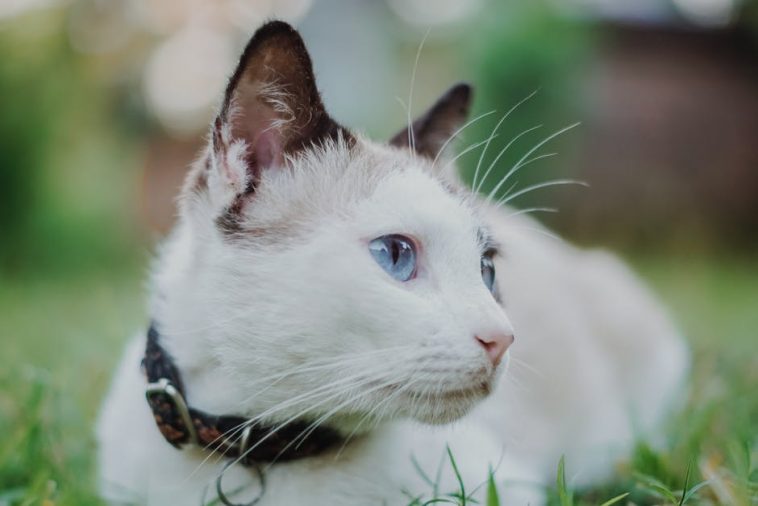Are Cats and Collars a Sensible Combination?
Placing a collar on a pet is, in theory, a form of responsible pet ownership. A properly fitted collar with an identification tag can save the life of a pet. But multiple incidents have been reported wherein a collar placed a pet, both dogs and cats, in harm’s way. Cats being more limber find themselves entangled more often in their collars than dogs, thus cats and collars can be a controversial topic. Are collars necessary in cats? Are they safe to use? Opinion on this subject is divided even in the veterinary community. Some believe that collars on cats are necessary for their welfare. Others believe that making cats wear collars is tantamount to animal cruelty.The Benefits of a Cat Collar
The foremost benefit of a cat collar is for identification in case the cat goes missing. Tags help to identify the cat and the owner so that the cat can be safely returned to the owner instead of being surrendered to a shelter where the cat may be put down if unclaimed. It is extremely important to think about purchasing a collar if you are moving house, especially if it is to a new neighbourhood. A cat collar can also be a life-saving accessory. Collars can have medical alert tags that contain health information about the cat like allergies, chronic conditions like feline diabetes. Reflective collars may help reduce the incidence of car accidents involving cats.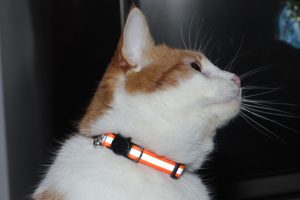
A reflective collar can help your cat be visible in the dark.
The Dangers Arising from Cats and Collars
There have been quite a number of reports about cat collar injuries and fatalities. These usually happen when the pet owner make the mistake of choosing the wrong kind of collar. But even the right kind of collar poses a hazard when it is improperly fitted.The Type of Collar
Some cats have sensitive skin. A collar may elicit an allergic reaction making the skin itchy, irritated and developing rashes. Collars with buckles, or any hanging attachment like tags and accessories, pose a danger for hanging, choking and strangulation in case the collar gets caught in branches, gates, fences, posts and other objects. Cats being natural hunters, climbers and explorers are at a very great risk for this. A collar made of inappropriate material also poses a danger to the cat. Frayed threads can get caught in the cat’s teeth potentially causing a cat to panic and get injured.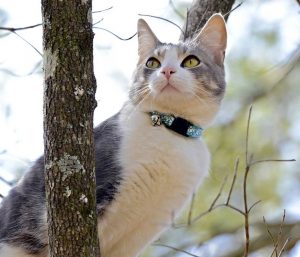
Collars may pose a danger of getting caught in a branch if your cat loves to climb trees. Make sure to choose a collar with a breakaway lock.
The Fit of the Collar
A collar that fits too loosely on the neck can result in the cat getting entangled in its own collar. It is usually the front limb that gets wedged between the collar and the neck when the cat tries to take the collar off. If the limb is not removed from entanglement, the pressure of the collar cutting into skin may cause the involved limb, the neck and the cat’s armpit to be wounded.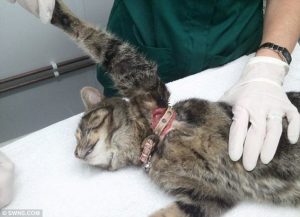
When a cat’s limb gets caught under a loosely fitting collar, this can result to laceration in the armpits.

A cat’s lower jaw can also get caught under a collar that is too loose.
Training a Cat to Wear A Collar
Can cats be trained to accept and wear a collar? For some cats, the answer is yes. It is ideal to start training while the cat is still young. The best place to practice the first few times is indoors because the cat or kitten might get agitated and bolt away. Place the collar on with just enough space to insert two fingers between the collar and the neck. This is the appropriate looseness of the collar. Supervise the cat and observe how the cat reacts to the collar for the first few weeks. Always remember to remove the collar when you are not present to monitor the cat if you are not yet sure the cat accepts the collar. But keep in mind that there are some cats that will simply refuse to wear a collar. They will promptly attempt to remove it after you place it on. Do not force a cat who is unwilling to wear a collar even after repeated attempts to train them. A cat can self-mutilate trying to take the collar off.Safety First in Choosing a Cat Collar
In choosing a collar for your cat, place safety features first over fashionable design. Select a collar that has what is called a “quick-release” or a “breakaway” lock which pops open when a pulling force is exerted on it. Do not buy collars with buckles because of the dangers they pose as mentioned above. Test the collar’s lock mechanism and make sure it is working properly before buying.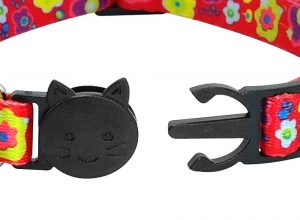
A properly working quick release lock should be the prime consideration when choosing a cat collar.
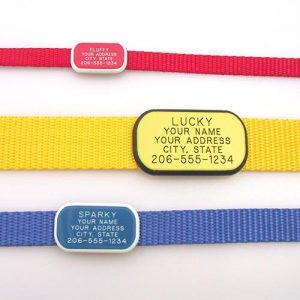
Ideally, identification tags should be attached to the collar and not dangling.
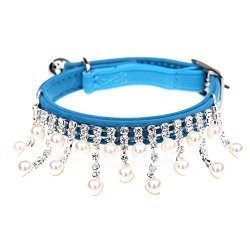
Use bling-studded collars with many dangling objects only when you are present to supervise the cat.
Cats and Collars – Are There Safer Alternatives?
If the purpose of the cat collar is only for taking the cat outside for a walk, a harness specially designed for cats is more appropriate. It fits all around the body to give you more control of your cat. Do not leave the harness on if you let your cat roam outside on its own.
A body harness is a better alternative over a cat collar when taking kitty outside for a walk.
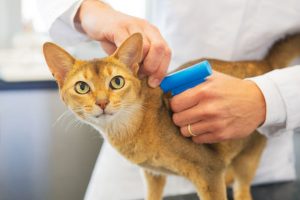
An implanted microchip is a better and more permanent form of identification for a cat over a collar.

